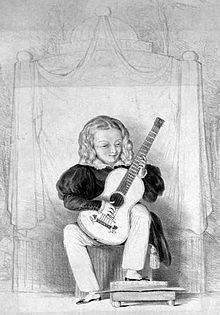Giulio Regondi


Giulio Regondi (1822 – 6 May 1872) was a Swiss-born classical guitarist, concertinist and composer active in France and (mainly) the United Kingdom.
Regondi was born of a German mother and an Italian father in Geneva, Switzerland. In 1831 Fernando Sor dedicated his Souvenir d'amitié op. 46 to Regondi, a child prodigy, when the boy was just nine.
There is a reference to his appearing in London in 1831, presented as a child prodigy of the guitar.[1] Most of Regondi's concertina music was written for the English system, however, at which he was a virtuoso,[2] though his guitar music is probably better known. His works for solo guitar comprise a set of etudes, variations on a theme by Bellini and five larger works.
Regondi died in London.
Selected works
- Nocturne 'Rêverie' op. 19, for guitar
- Fête villageoise 'Rondo caprice' op. 20, for guitar
- Air varié No. 1 op. 21, for guitar
- Air varié No. 2 op. 22, for guitar
- Introduction and caprice op. 23, for guitar
- Ten Études, for guitar
- Feuillet d'album for guitar
- Fantasie über Mozarts Don Giovanni (Solo on Don Giovanni, partly from Thalberg's piece) for guitar (1840) rediscovered in 2007
- Air varié de l’opera de Bellini I Capuleti e i Montecchi for guitar (1845) rediscovered in 2007
- Fantasia on English Airs, for concertina and piano
- Leisure Moments (1-6), for concertina and piano (1857)
- Morceau de salon, for concertina and piano
- Recollections of Home, for concertina
- Ecce ridente il cielo, for concertina
External links
- (in Italian) Articles on Regondi by Alessandro Boris Amisich
- Giulio Regondi in Ireland by Thomas Lawrence (ref)
- The poem
 To Giulio Regondi. The Boy Guitarist., by Felicia Hemans was published in 1840, after the poet's death in 1835. It cannot have been written later than 1834.
To Giulio Regondi. The Boy Guitarist., by Felicia Hemans was published in 1840, after the poet's death in 1835. It cannot have been written later than 1834.
- Publications
- Concert Works for Guitar opp.19-23 edited by Simon Wynberg (Chanterelle Verlag)
- Air varié de l’opera de Bellini: I Capuleti e i Montecchi edited by Stefan R. Hackl Archived 2011-07-06 at the Wayback Machine (Editions Orphée)
- Giulio Regondi: Ten Etudes revised and edited by Matanaya Ophee (Editions Orphée)
- Sheet music
- Rischel & Birket-Smith's Collection of guitar music 1 Det Kongelige Bibliotek, Denmark
- Boije Collection The Music Library of Sweden
- George C. Krick Collection of Guitar Music Washington University
- Free scores by Giulio Regondi at the International Music Score Library Project (IMSLP)
- Images
- Images of Giulio Regondi (Royal Academy of Music)
- Giulio Regondi, "The Young Guitar player as he appeared on the 3rd of Sepr. at the Royal Adelphi Theatre."
- Image
- Image (Article: A 41-cent emendation)
References
- ^ The Times, 16 June 1831; p. 3; "A NEW MUSICAL FUND: […] An interesting little boy of the name of Regondi, apparently between six and seven years of age, performed a fantasia on the guitar, with most manly power and surprising brilliancy. He was seated on a stool, which was placed on the pianoforte […].”
- ^ The Times, 26 April 1837; p. 5; "GREAT CONCERT-ROOM – KING'S THEATRE […] There was also a novelty in the shape of an instrument called 'a concertina,' an improvement on the accordion, which has been such a favourite musical toy for the last two or three years. The tones of this instrument are sweet and pleasing; but far more striking than the concertina itself were the feeling and ease with which it was played by that clever little boy Giulio Regondi, who executed several intricate passages with surprising facility and precision."
